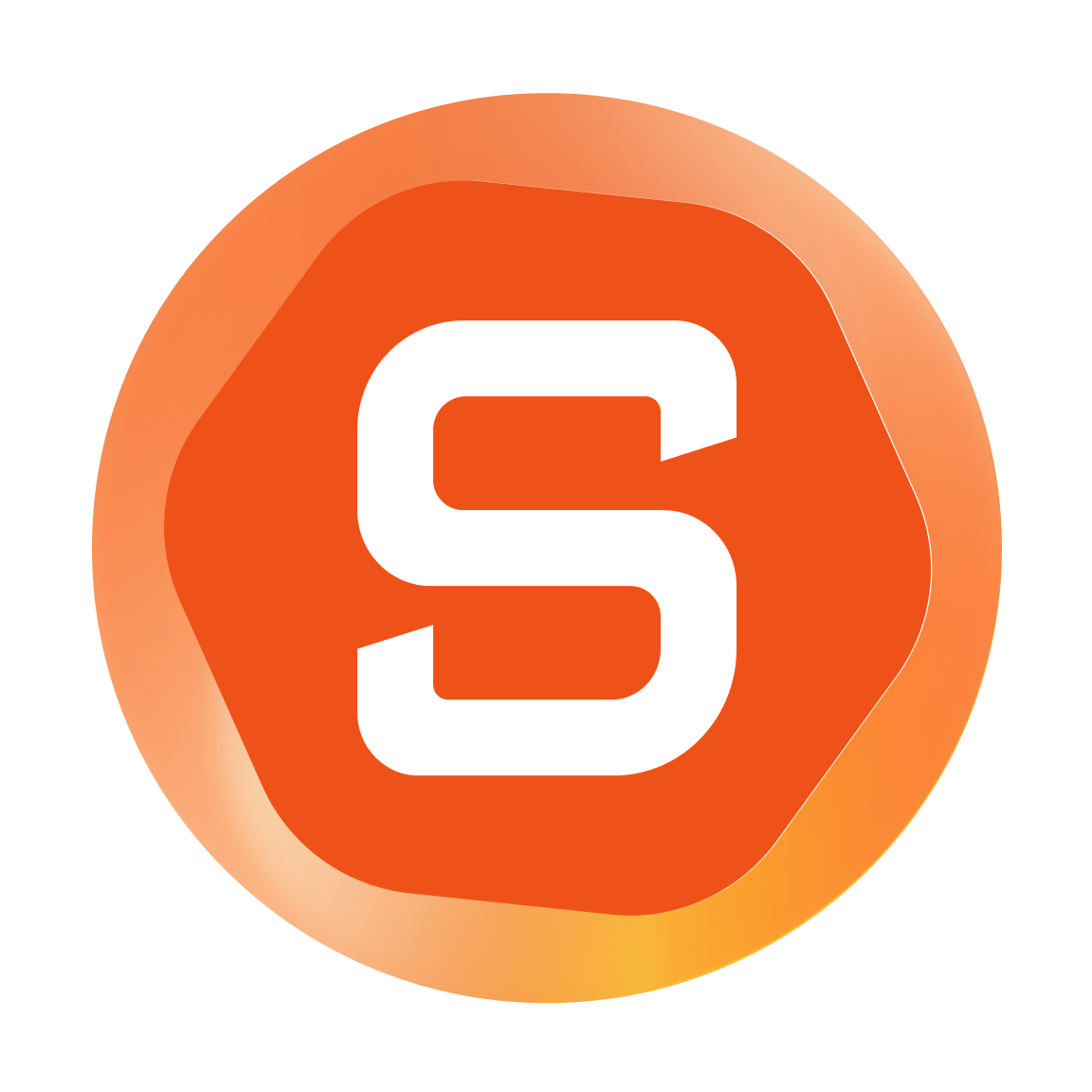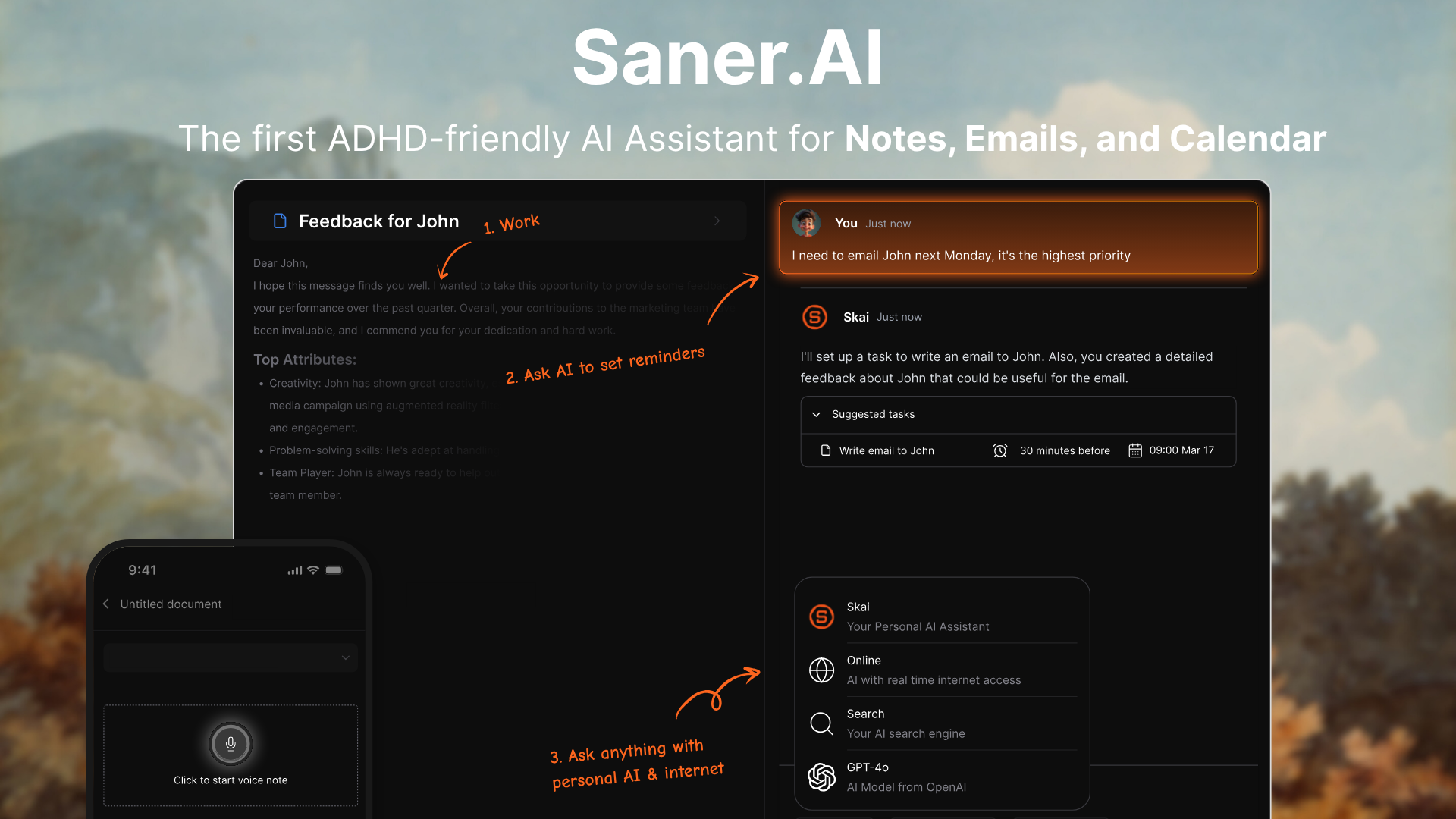We Tested 8 Best AI Tools for Busy People (Free & Paid)
The Best AI Tools for Busy People are: Saner.AI, ChatGPT, Reclaim.AI, Superhuman, Fathom, Grammarly, Gamma, and Napkin

AI Tools for Busy People: We Tested and Ranked the 8 Best Apps
You’ve got 12 tabs open, 3 meetings back-to-back, and no time to breathe. Sound familiar? For the busy professional, entrepreneur, the constant juggle of emails, calendars, meetings, and scattered documents can feel overwhelming.
That’s where smart AI tools come in - not flashy gadgets, but practical helpers that reclaim your time, reduce the mental clutter, and let you actually focus.
In this guide, we’ll walk you through the best AI tools for busy people - tools designed for people with more tasks than hours, more ideas than space, and more demands than bandwidth.
We’ll cover 8 tools that actually make your day smoother - from AI schedulers to smart note-takers - and help you pick the right ones, see real-world use cases, and stay ahead of where this is all going.
What Makes an AI Tool Great for Busy People
Before we dive into the tools, let’s clarify what “AI for busy people” really means -and what to look for.
What does “AI for busy people” mean?
It means tools that:
- Automate or offload repetitive mental work (like scheduling, note-taking, email triage)
- Respect your limited attention and guard your focus time
- Integrate smoothly with your existing workflow (calendar, docs, email, tasks)
- Are easy to adopt and don’t themselves become another distraction
Key Criteria: What to look for
Here are the main features you should check:
- Ease of use / minimal learning curve: If it takes longer to learn than the time it saves, pass.
- Automation of repetitive admin tasks: e.g., scheduling, summarising, tagging.
- Cross-platform or workflow integration: Works with the apps you already use (G Suite, Outlook, Slack, etc.).
- Proactive assistance + context awareness: Not just “you ask the AI” but “AI helps anticipate and clear the path”.
- Focus-friendly design: Protecting deep work time, reducing interruptions, and reducing context switching.
How I Tested These Tools
I didn’t just read reviews - I used each tool in my actual workflow for a few weeks.
- Real work: I ran meetings, wrote emails, and managed projects with them daily.
- Time saved: Anything that took more effort than it saved got dropped.
- Focus impact: I tracked whether the tools helped me stay on task or just added noise.
- Cross-device and integration: Each one had to work smoothly across laptops, phones, and common apps like Google Calendar or Slack.
- Ease of use: If I couldn’t learn it in under 30 minutes, it didn’t make the list.
Only the tools that truly saved time, reduced context switching, and made work feel lighter were selected.
Now, let's dive in!
What are the Best AI Tools for Busy People?
The Best AI Tools for Busy People in 2025 are: Saner.AI, ChatGPT, Reclaim.AI, Superhuman, Fathom, Grammarly, Gamma, and Napkin
🔍 Comparison Table - Best AI Tools for Busy People
| 💡 Tool | 🧭 Best For | ⚙️ Key Features | 🎯 Why It Helps Busy People | 👥 Ideal For |
|---|---|---|---|---|
| Saner.AI | Organizing notes, ideas, and tasks in one place | Centralized workspace for notes, emails, and documents • Smart AI search across all info • Plan tasks automatically | Reduces context switching and mental clutter by keeping everything connected | Entrepreneurs, researchers, ADHD professionals |
| ChatGPT | Writing, ideation, summarizing, and brainstorming | Conversational AI that can draft, explain, and summarize • Broad use cases from writing to coding • Natural language interface | Works like a digital co-pilot for all kinds of tasks, freeing time from research and writing | Entrepreneurs, content creators, anyone multitasking |
| Reclaim.AI | Scheduling and protecting focus time | Automates task and meeting scheduling • Syncs with calendars • Adjusts time blocks dynamically | Keeps your calendar realistic and focused while automatically balancing priorities | Managers, team leads, freelancers |
| Superhuman | Managing and responding to email efficiently | AI-powered triage and prioritization • Instant replies and smart shortcuts • Clean interface designed for speed | Cuts through inbox overload and helps you achieve inbox zero faster | Executives, founders, high-volume email users |
| Fathom | Recording and summarizing meetings | Auto-records and transcribes calls • Generates summaries and action items • Integrates with team tools | Lets you focus on the conversation while AI handles the notes and follow-ups | Managers, consultants, remote teams |
| Grammarly | Writing clear, polished communication | Grammar and tone correction • AI rewrite suggestions • Works across apps and browsers | Speeds up writing while ensuring everything sounds professional and error-free | Writers, students, professionals |
| Gamma | Creating presentations and reports quickly | Turns text into decks and reports • Beautiful templates • Collaborative editing | Saves hours on slide design — just focus on the message, not formatting | Marketers, educators, founders |
| Napkin | Turning ideas into quick visuals | Converts text into flowcharts and infographics • Simple drag-and-drop interface • Great for brainstorming visuals | Helps you explain ideas visually without needing design skills | Consultants, educators, visual thinkers |
1. Saner.AI - AI Personal Assistant
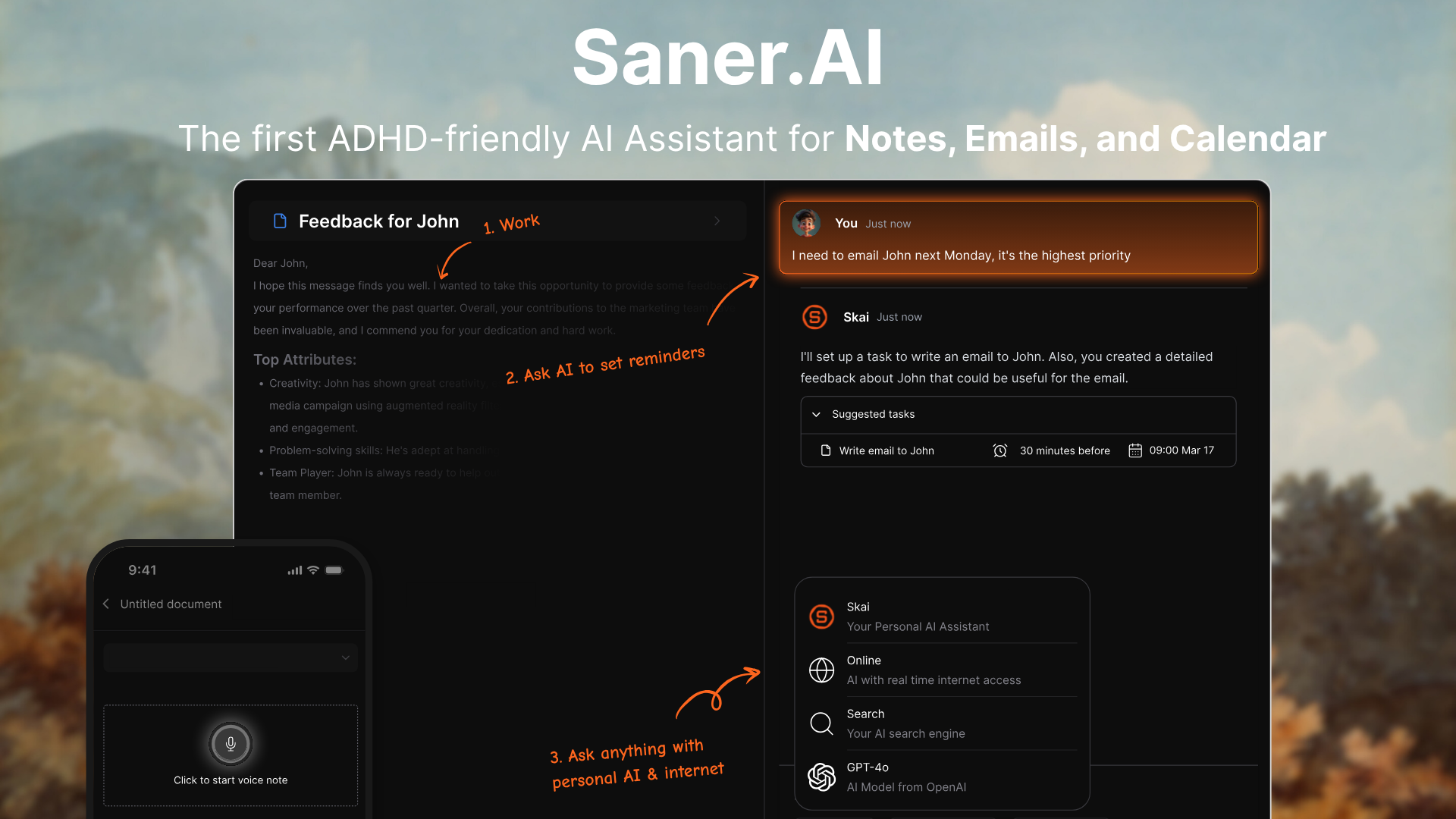
Saner.AI is an all-in-one AI assistant built to help busy people manage chaos. It brings your notes, tasks, emails, and scattered thoughts into one organized place - and turns them into actions. Think of it as an AI personal workspace that understands what matters, keeps track of it, and helps you stay focused without juggling multiple tools.
Key features
- Daily planning: The AI gives you an optimal plan for your day based on what’s urgent, due, or easy to start

- Smart task extraction: Automatically pulls to-dos from your emails
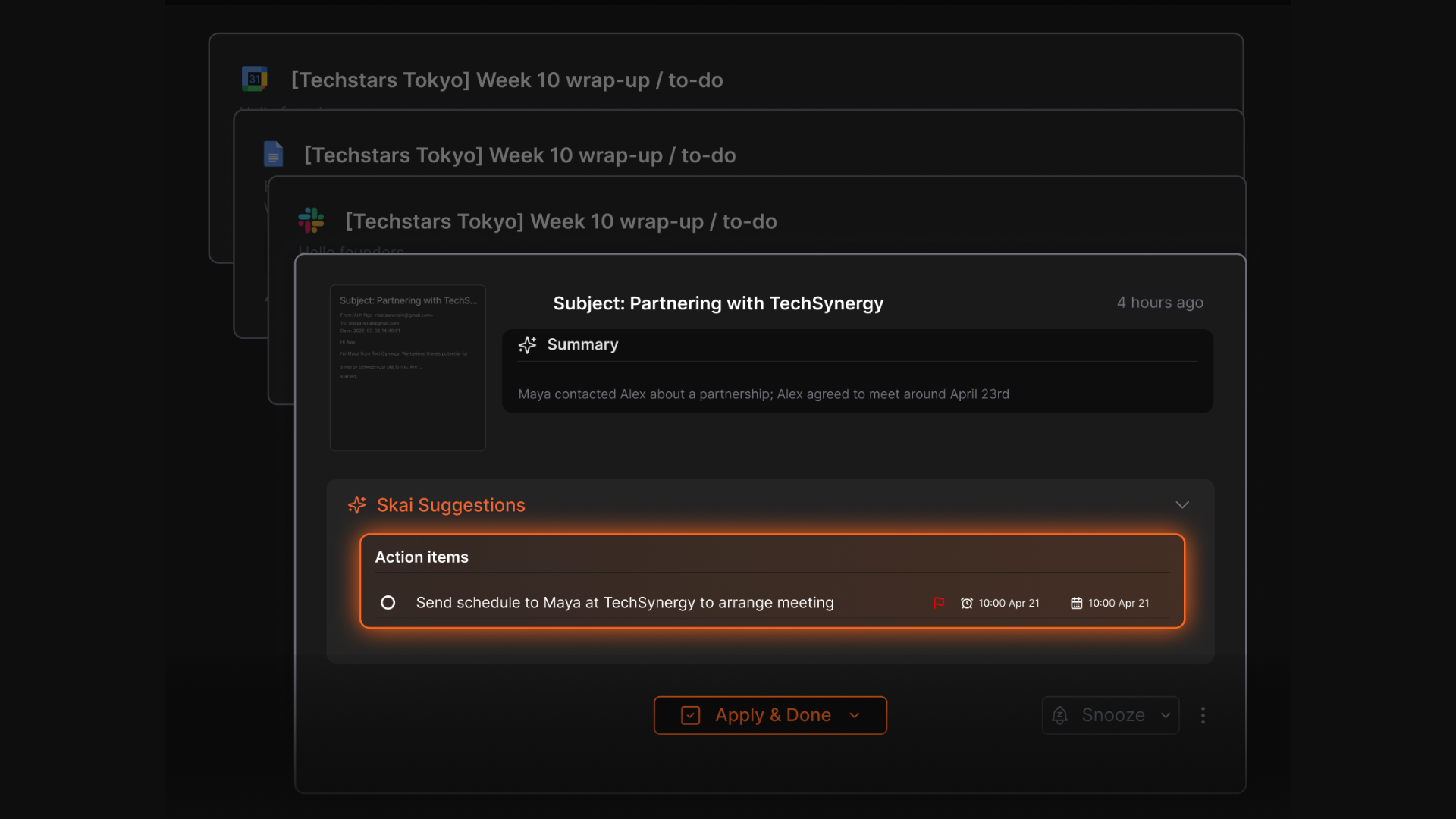
- AI understanding & search - Lets you ask questions in natural language (e.g., “what did I plan for the project last week?”) and instantly finds or summarizes what you need.

- Email & document sync: Connects with Gmail, Google Drive, and other sources to pull important information and summarize what’s relevant.
- Cross-platform capture: Includes a Chrome extension and mobile app to jot down or clip ideas instantly.
What I liked
- Brain-dump to tasks: Converts your messy notes or thoughts into clear, actionable to-dos automatically - perfect for overwhelmed minds..
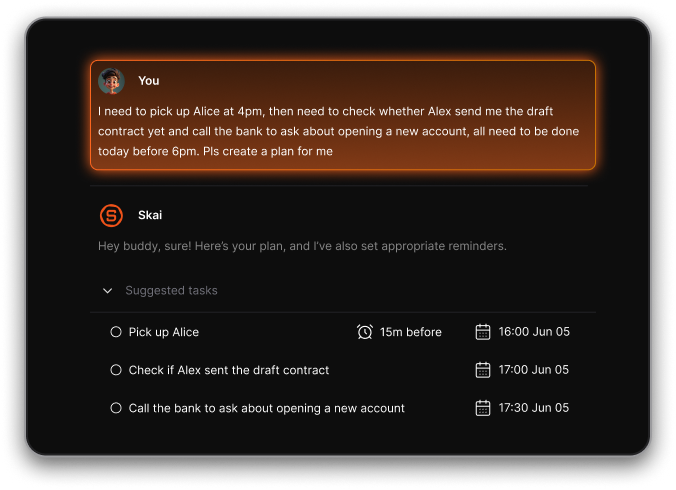
- The AI organization saves time - no need for tagging, folders, or manual categorizing. It automatically groups ideas, notes, and tasks by meaning.
Cons
- Not ideal for large teams or project timelines - no Gantt charts or complex task dependencies.
Pricing
- Free
- Starter: Monthly at $8/month, Annually at $6/month (with early user discount)
- Standard: Monthly at $16/month, Annually at $12/month (with early user discount)
Who is it suitable for?
- Busy professionals who want to replace multiple apps with one calm AI assistant.
- Entrepreneurs, researchers, and creators who deal with scattered notes and need AI to organize their thinking.
- ADHDers or fast-paced thinkers who struggle with manual systems but still want structure.
- Anyone tired of context-switching between task apps, note tools, and inboxes.
Saner.AI review

How to start using it?
- Sign up for a free account on Saner.AI.
- Import your notes, emails, or files to let the AI understand your work context.
The AI Tool that works for Busy People
2. ChatGPT - General AI

ChatGPT is a conversational AI assistant that helps you brainstorm, write, code, plan, and automate tasks through natural conversation
Key features
- Multimodal input & output: supports text, voice, image, and file inputs for natural interaction
- Advanced reasoning models (GPT-5): faster, smarter, and more accurate responses
- Memory & personalization: remembers your preferences and previous chats for contextual replies
- Integrations & automation: connects with apps and workflows to streamline repetitive tasks
What I liked
- Extremely flexible - works for writing, research, coding, or planning without switching apps
- Multimodal capabilities make it easy to drop in files, images, or even voice notes when you’re in a rush
- Continuous updates keep it current with new features
What I disliked
- Still requires human supervision - not fully autonomous or “set it and forget it”
- No AI assistant to manage your to-do list
Pricing
- Free plan available
- Plus plan at $20/month
- Pro plan at $200/month
Suitable for
- Professionals, freelancers, and entrepreneurs who want to save time on writing, research, or admin tasks
How to start
- Visit chat.openai.com or download the ChatGPT app
- Create a free account and test basic features
ChatGPT Review (source)

3. Reclaim - AI Calendar

Reclaim.ai is an AI assistant that helps you take control of your time. It works behind the scenes to automatically block time on your calendar for tasks, meetings, habits, and breaks - without the need for constant manual tweaking.
Key features
- Smart Time Blocking: Automatically protects time for deep work, tasks, and personal routines like workouts or learning
- Automated Task Scheduling: Syncs with tools like Asana, Todoist, and Jira so tasks appear directly on your calendar
- Meeting Scheduling: Finds optimal meeting times, shares scheduling links, and adds buffers before or after meetings
Pros:
- The Smart Scheduling: you set priorities and deadlines, and Reclaim finds the right time slots automatically
- Habits are flexible, so you can easily protect time for things like reflection or workouts

Cons:
- There’s no fully featured mobile app yet, which makes it harder to manage on the go
- It’s not a full project management tool
- ❌ Doesn't have a chatbot interface
Pricing:
- Free plan available with limited features
- Starter plan around $10/user/month
- Business plan around $15/user/month
Suitable for:
- Professionals, freelancers, and managers who rely on Google Calendar
- Teams that want to automate time blocking and reduce meeting overload
- People looking to defend focus time rather than manage projects
How to start:
- Go to reclaim.ai and create a free account
- Connect your calendar (Google or Outlook beta)
Reclaim.AI Reviews (source)

4. Gamma - AI Presentation

Gamma is an AI-powered tool that helps you turn ideas into polished presentations, documents, or even web pages - in minutes. It removes the need for tedious formatting or design work, which makes it ideal for busy professionals who want to communicate ideas fast without getting stuck in PowerPoint.
Key features
- Prompt-to-presentation: Turn a short prompt or uploaded notes into a complete deck or doc instantly.
- Multi-format output: Create presentations, documents, or web-style pages from the same workflow.
- Upload + prompt combo: Feed in outlines, files, or notes and let Gamma structure and design them for you.
What I liked
- It’s fast
- The prompt-based flow saves hours - it’s fast, intuitive, and great for people who don’t have time to design slides.
- The modern scrolling format feels fresh and readable, especially on mobile or web.
What I disliked
- Limited control for advanced design users - you can’t fine-tune every visual detail.
- Integrations with enterprise tools like PowerPoint or Google Slides are still developing.
- Not ideal for data-heavy or highly customized corporate presentations.
Pricing
- 25$/month
Suitable for:
- Busy professionals, freelancers, and teams who want to turn ideas into decks fast.
- Less suitable for design-heavy teams that need full creative control or brand customization.
How to start:
- Go to Gamma’s website and sign up for a free account.
- Start with a simple prompt
Gamma reviews (source)

5. Superhuman - AI Email

Superhuman is an AI email client. It connects with Gmail or Outlook and wraps them in a fast, minimal, keyboard-driven interface. Designed for busy professionals, it helps you process your inbox in half the time, draft smarter replies, and stay focused without the clutter of traditional email tools.
Key features
- Lightning-fast interface: Opens instantly and keeps everything responsive, even with large inboxes.
- Keyboard-driven workflow: Over 100 shortcuts to triage, reply, and archive without touching your mouse.
- AI writing & summarizing: Drafts replies in your tone, summarizes long threads, and reminds you to follow up.
- Split Inbox: Separates important emails (like VIPs or clients) from the noise so you can focus on priorities.
What I liked
- The interface is fast - emails load and send in milliseconds.
- It genuinely helps clear inboxes faster, which busy people will love.
- The AI drafting feels natural and saves time writing repetitive responses.

What I disliked
- It’s expensive compared to most email clients, at around $30/month.
- There’s a learning curve if you’re not used to keyboard shortcuts.
Pricing
- Starter: $30/user/month (or $25/month if billed annually)
- Business: $40/user/month (or $33/month annually)
Suitable for:
- Busy professionals, founders, and executives managing high-volume inboxes.
- People who want to save time and handle email with speed and precision.
How to start:
- Go to superhuman.com and sign in with your Gmail or Outlook account.
Superhuman Review (source)

6. Grammarly - AI Writing Assistant

Grammarly is an AI writing assistant that helps you write faster, clearer, and more confidently - whether you’re crafting emails between meetings or finishing reports late at night. It works across browsers, documents, and mobile apps
Key features
- Real-time grammar, spelling, and punctuation checks that instantly flag errors
- Tone and style suggestions that help you sound natural and appropriate for your audience
- AI-powered rewriting tools for paraphrasing, summarizing, or adjusting tone
What I liked:
- The real-time corrections save time - no need to re-read every message or draft twice
- The tone detector helps you stay professional in work messages without sounding robotic
What I disliked:
- Many of the best AI writing tools (rewriting, AI detection, brand tone) are locked behind Premium or Business plans
- Mobile typing experience feels slightly slower compared to desktop
Pricing:
- Free plan available
- Premium plan starts at $12/month (billed annually)
Suitable for
- Content creators, marketers, and freelancers who want polished writing fast
- Students or researchers who want clarity and originality in their work
How to start
- Go to Grammarly’s website and create a free account
- Install the browser extension or desktop app
Grammarly review (source)

7. Napkin - AI Visualizer

Napkin AI is a text-to-visual generator that helps you turn ideas, notes, or outlines into clear visuals like diagrams, infographics, or slides in seconds. It’s built for busy professionals who want to communicate visually without spending hours designing.
Key features
- Text-to-Visual Conversion: Paste your text and Napkin instantly generates visuals that match your content.
- Editable Visuals: Adjust colors, layouts, and icons to fit your message or branding.
- Multi-format Export: Download visuals in PNG, PDF, PPT, or SVG.
What I liked
- It’s incredibly fast. You can turn notes into usable visuals in minutes.
- No design experience required - great for non-designers who still want visuals that look good.

What I disliked
- Customization is limited compared to full design tools like Figma or Canva.
- Integrations are still basic; you’ll need to download and upload visuals manually if you use Notion, Miro, or others.
- It’s web-based only, with no mobile app or offline mode yet.
Pricing
- Free: Basic features with Napkin branding and limited credits.
- Plus Plan: Around $9–12/month, removes branding and adds more exports.
- Pro Plan: Around $22–30/month, adds brand kits, higher limits, and team features.
Suitable for
- Busy professionals who need quick visuals for reports, slides, or posts.
- Marketers and content creators who want to show ideas fast without a designer.
How to start
- Go to Napkin.ai and create a free account.
- Paste your text or upload notes, then click generate to create visuals.
8. Fathom - AI Meeting Note

Fathom is an AI meeting assistant that records, transcribes, and summarizes your online calls so you can focus on the conversation instead of taking notes. It automatically captures highlights and creates instant summaries
Key features
- Automatically records, transcribes, and summarizes meetings on Zoom, Google Meet, and Microsoft Teams
- Instantly generates action items and highlights after each call
- Lets you mark key moments during a meeting with one click
What I liked
- The free plan is surprisingly generous
- You can stay fully present in meetings without worrying about missing anything
- The summaries and action items are ready right after the call ends
What I disliked
- Some advanced features, like custom summaries and team analytics, are only available in paid plans
- There’s no full mobile app experience, which limits flexibility for on-the-go users
Pricing
- Free plan available with unlimited recordings and transcriptions
- Paid plans start around $20/month for individuals
Suitable for
- Busy professionals who attend frequent meetings and want to automate note-taking
- Small teams or startups that need searchable, shareable meeting summaries
How to start
- Sign up for a free account on Fathom’s website
- Install the desktop app or browser extension for Zoom, Google Meet, or Teams
Fathom review (source)

🧭 Conclusion: Let AI Do the Admins, So You Don’t Have To
Being “busy” used to mean doing more. Today, it’s about doing what matters - and letting smart systems handle the rest.
The truth is, most people don’t need more productivity hacks - they need fewer things stealing their attention.
The best AI tools for busy people aren’t the ones with the most features. They’re the ones that quietly reduce friction, automate the boring parts, and give you back the mental space to think, create, and breathe.
Whether it’s Reclaim.AI defending your focus time, Fathom remembering your meetings, Superhuman cutting through email noise, or Saner.AI pulling your scattered thoughts to a plan - each of these tools serves one goal: helping you stay human in a world that keeps speeding up.
So don’t try them all at once. Start with one small upgrade - one that solves your biggest daily drain. Let it earn its place in your routine.
And if your brain feels constantly cluttered with notes, tasks, and ideas, try Saner.AI - it’s built to bring calm back into your digital life.
Because productivity isn’t about doing everything.
It’s about finally having the headspace to do what truly matters.
Stay on top of your work and life
FAQ: Best AI Tools for Busy People
1. What qualifies as a “busy person”?
A busy person is someone juggling constant tasks - back-to-back meetings, never-ending emails, and shifting priorities - who wants to save time and mental energy. The best AI tools for busy people automate the small stuff, reduce decision fatigue, and give you back hours every week.
2. Why should busy people use AI tools?
AI tools act like extra hands for your brain. They help by:
- Automating repetitive work like email drafting or scheduling.
- Reducing mental load by surfacing what matters most.
- Keeping your day structured without constant manual effort.

- Helping you focus on the work that actually moves the needle.
3. Which AI tools are best for busy people?
Here’s a quick breakdown of top tools worth exploring:
- Saner.AI - Combines notes, calendar, and tasks into one calm workspace that helps you think and act faster.

- ChatGPT – A flexible conversational AI for brainstorming, summarizing, and drafting content.
- Reclaim.AI – Auto-schedules time blocks for focus work, habits, and meetings based on your priorities.
- Superhuman – An AI-powered email app that helps you clear your inbox in record time.
- Fathom – A meeting assistant that records, transcribes, and surfaces key takeaways automatically.
- Grammarly – An AI writing helper that makes your communication clear and professional.
- Gamma – Instantly turns your ideas into polished slides or documents.
- Napkin – An intelligent tool for connecting ideas, summarizing insights, and capturing thoughts visually.
4. How do I choose the right AI tool for my workflow?
Ask yourself:
- What’s draining my time the most - emails, meetings, or task overload?
- Do I prefer one all-in-one workspace or multiple specialized tools?
- How much setup time can I handle right now?
Pick one pain point first, solve it, then layer more tools gradually.
5. Can these AI tools work together?
Yes. The best productivity setups combine tools:
- Let Saner.AI surface the tasks or notes you need every day.
- Rely on Grammarly or ChatGPT to refine your communication.
- Use Fathom to summarize meetings and feed action items back into Saner.AI.
Together, they form a connected productivity system that runs smoothly behind the scenes.
6. Are there free versions available?
Most of these tools offer free or freemium plans so you can try them before committing:
- Saner.AI – Free tier for basic task reminders and note search.
- ChatGPT – Free with limited access
- Grammarly – Free version for essential writing feedback.
- Reclaim.AI – Free scheduling automation for individuals.
7. What mistakes do busy people make when using AI tools?
- Trying to automate everything from day one.
- Letting tools add complexity instead of reducing it.
- Switching between too many apps instead of mastering a few that truly help.
8. How do AI tools improve time management?
They analyze your calendar, understand your priorities, and automate low-value work. For example:
- Saner.AI can auto-schedule or suggest time slots for key tasks.
- Superhuman reduces time spent managing emails.
- Gamma and ChatGPT help you create polished documents in minutes.
These small time savings compound into major weekly gains.
9. Which AI tools help with deep work and focus?
- Reclaim.AI protects uninterrupted focus blocks.
- Saner.AI minimizes mental clutter by combining notes, tasks, and reminders.
- Napkin supports visual thinking and creative focus.
The goal: less distraction, more flow.
10. Do these AI tools support teamwork?
Absolutely.
- Fathom helps teams capture meeting outcomes without note-taking.
- Grammarly ensures polished communication across shared docs.
- Reclaim.AI syncs team schedules for smarter collaboration.
- Saner.AI can serve as a shared workspace for notes and projects.
So even if you’re personally overloaded, your team stays aligned.
11. How can I start using AI tools if I’m already swamped?
Start small. Pick one area of friction:
- Too many emails → Try Superhuman.
- Meeting overload → Try Fathom.
- Constant information chaos → Try Saner.AI.
- Unstructured calendar → Try Reclaim.AI.
Focus on a single pain point. Once you feel the relief, expand your toolkit.
12. What’s the real ROI of using AI tools for busy people?
Time and clarity.
AI tools save hours weekly by reducing context switching, summarizing information, and helping you focus on important work. You’ll notice fewer dropped balls, faster responses, and more headspace for deep thinking.
13. How do I measure if these tools are actually helping?
Track three simple things:
- How often you context switch between apps.
- How many tasks or emails stay unfinished by day’s end.
- Whether you feel more in control of your week.
If your stress drops and output rises, the tools are doing their job.
15. Do I need one all-in-one tool or multiple specialized ones?
It depends on your style:
- Go all-in-one with Saner.AI if you want simplicity and everything connected.
- Use specialized tools like Reclaim.AI, Superhuman, or Grammarly if you want advanced control in each area.
Many busy professionals use a mix - one core hub plus a few focused helpers.
Make your day easier with the top AI tools
